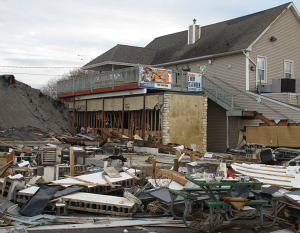Superstorm Sandy landed one final stunning blow to New Jersey on Thursday, Jan. 24, as the state adopted rebuilding guidelines that come with sticker shock.
They will force homeowners in flood zones to spend tens of thousands of dollars to raise their houses now or pay exorbitant premiums of up to $31,000 a year for flood insurance later.
Gov. Chris Christie said he adopted flood maps issued late last year by the Federal Emergency Management Agency as New Jersey’s standard for rebuilding from the worst storm in its history.

The superstorm destroyed more than 30,000 homes, caused $37 billion in damage and is still keeping 41,000 people out of their damaged homes.
He also said there are “very few places” where New Jerseyans won’t be able to rebuild if the higher buildings standards are used.
Christie, a Republican running for re-election this November and a strong early contender for the 2016 GOP presidential nomination, stressed that the guidelines don’t force anyone to raise their homes. But he laid out a stark choice: do the elevations called for under the FEMA maps or pay through the nose for flood insurance each year.
“If you choose not to, you’ll have substantially higher flood insurance costs, which could be … seven or eight times what you pay now,” he said at a news conference in Seaside Heights, where the storm wrecked the boardwalk and pitched a roller coaster into the ocean in one of Sandy’s defining images.
“There’s going to have to be some hard decisions made,” Christie said. “But for the shore as a whole, I think that’s the right decision to make.”
The new rules took effect immediately.
Three months after Sandy hit, many homeowners are still dazed, trying to navigate a maddening maze of insurance companies, government regulations and their own dwindling finances. Most say they have been unable to make crucial decisions on whether and how to rebuild until clear rules were set telling them how high they had to go.
While several expressed gratitude for a clearer road map for the future, the expenses involved staggered some.
Linda Stefanik of Seaside Park is wrestling with whether to raise her business and a house she owns with her sister.
“It’s a lot to take in,” she said. “It’s going to average between $30,000 and $60,000 for everyone who’s going to do it. Seaside Park is not all rich people. If they can’t get some grants, I don’t know if a lot of them will be able to do it.”
Government grants of up to $30,000 are available to help offset the cost of elevating homes. But some homeowners say they need to start work now, which means fronting the money themselves and hoping for reimbursement later. Chuck Appleby of Seaside Park is one of them.
“The cost of raising my house is $60,000,” he said. “It’s easy to say that’s just two years of what you would pay in higher insurance costs, but if you don’t have that kind of money, you’re stuck.”
Appleby has been unemployed since May 2011 when the U.S. Army’s Fort Monmouth closed and transferred its remaining jobs to Maryland. Since then he’s been living on savings, which have rapidly dwindled since the storm as he and his family live in a rental.
And his parents, who live nearby, have no plans to raise their home. He says they’re in for a shock.
“Their entire annual income is about $30,000,” he said. “I don’t know what people like them are going to do.”
Christie said there will be government assistance programs set up with some of the federal storm aid expected to go up for a U.S. Senate vote Monday. He also said a main goal is to make sure the Jersey shore remains affordable.
Yet he said there’s a certain amount of expense and pain that people are going to have to absorb.
“I’m doing the best I can to help folks,” Christie said. “But the government cannot be the guarantor of a good result for everyone. I can’t fix every problem. Any politician who gets behind a mic and tells you they can fix every problem is a liar.”
The advisory maps issued by FEMA in December show the flooding risk is much greater than was projected when the current maps came out in the 1980s. They also expand the area where forceful waves are considered a risk.
Homes that used to be in a less-dangerous zone and are now in the velocity zone considered susceptible to the force of pounding waves could have to pay $31,000 annually in flood insurance costs, the governor said.
But if those same homeowners rebuilt to the higher recommended elevations, their insurance premiums would be about $7,000, and if they chose to go 2 feet higher than the new standard, which varies by location, they would pay about $3,500 a year, Christie said.
Topics Flood Homeowners
Was this article valuable?
Here are more articles you may enjoy.


 New York Governor Hochul Vows to Tackle Insurance Affordability, Litigation and Fraud
New York Governor Hochul Vows to Tackle Insurance Affordability, Litigation and Fraud  10 Highest Class-Action Settlements in 2025 Eclipsed $70B Total: Duane Morris
10 Highest Class-Action Settlements in 2025 Eclipsed $70B Total: Duane Morris  CEOs on Guard as Trump Rattles Companies With Series of Edicts
CEOs on Guard as Trump Rattles Companies With Series of Edicts  Experian: AI Agents Could Overtake Human Error as Major Cause of Data Breaches
Experian: AI Agents Could Overtake Human Error as Major Cause of Data Breaches 

